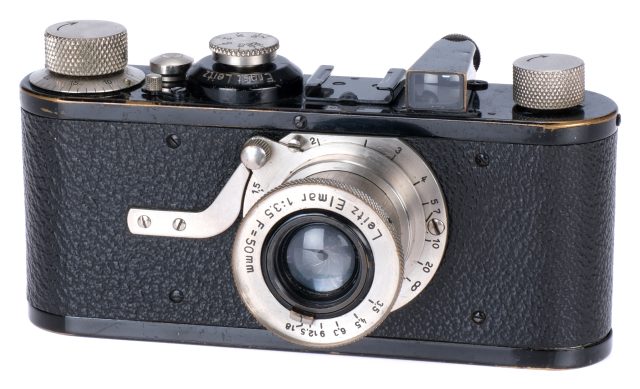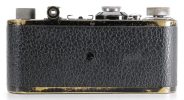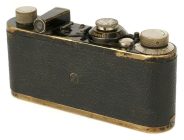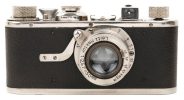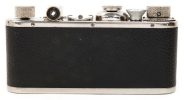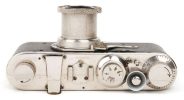Announced
Production status
System
Leica SM system cameras
- Leica ‘Prototype 2’ Replica with Anastigmat 50mm F/3.5
- Leica 0-Serie Replica with Anastigmat 50mm F/3.5
- Leica I (Model A)
- Leica I (Model B)
- Leica I (Model C)
- Leica Ic
- Leica If
- Leica Ig
- Leica II (Model D)
- Leica IIc
- Leica IIf
- Leica III (Model F)
- Leica IIIa (Model G)
- Leica IIIb (Model G)
- Leica IIIc
- Leica IIId
- Leica IIIf
- Leica IIIg
- Leica Standard (Model E)
- Leica "72"
- Ur-Leica
Leica I (Model A)
35mm MF film viewfinder camera • Discontinued
Specification
| Format: | |
| 35mm full frame | |
Film type: | 135 cartridge-loaded film |
| Shutter: | |
Type: | Focal-plane |
Model: | Mechanical |
| Exposure: | |
Exposure metering: | None |
Exposure modes: | Manual |
| Rangefinder and Viewfinder: | |
Rangefinder: | Accessory (HFOOK) |
Viewfinder: | Built-in |
Parallax compensation: | - |
| Physical characteristics: | |
Weight: | 475g |
Dimensions: | 132x55x30mm |
Manufacturer description #1
LEITZ "BARNACK"-KAMERA
DIE IDEAL-KAMERA FÜR DEN AMATEUR, REPORTER, TOURISTEN, FORSCHUNGSREISENDEN
Hauptvorzüge:
Äußerste Handlichkeit, Schnellste Aufnahmebereitschaft, Herrvorrangende Lichtstärke (1:3.5), Außerordentliche Bildschärfe, fur beträchtliche Vergrößerung geeignet, Vorzüglicher Schlitzverschluß, 40 Aufnahmen auf einer Kinofilmspule, Geringster Materialverbrauch, Erstklassige Ausführung.
Außere Größe: 13,2x5,5x3 cm
Gewicht mit gefüllter Kassette für Aufnahmen: 475 g
Bildformat (zur Vergrößerung): 24x36 mm.
Die "BARNACK" kamera ist die kleinste Schlitzverschluß-Kamera und bietet neue praktische und künstlerische Möglichkeiten.
ERNST LEITZ OPTISCHE WERKE WETZLAR
Manufacturer description #2
This apparatus is a camera with focal plane shutter equipped with a rapid Leitz 'Elmax' anastigmatic lens F/3.5 of 50 mm focus. The picture measures 36x24 mm. The camera takes cinematograph films of standard size. The latter is contained in a roll film chamber of special design. As the shutter is wound the film coils automatically past the film window upon a receiving bobbin, the amount taken up by the latter being every time exactly equal to the width of a picture. When the film is exhausted it is spooled back into the film cartridge chamber with the aid of a spool reversing knob. The full length of film which the cartridge will take is 1.60 metre (64 inches) and suffices for thirtysix exposures. Films of any shorter length may, however, be put in.
Manufacturer description #3
In the Leica Camera the photographic material used is the standard cinematograph film which is obtainable in all parts of the world. Instead of the usual cinematograph picture measuring 24 x 18 mm, however, the camera produces pictures of double the standard cine size, that is 36 x 24 mm, this being the first camera in which such a plan has been put into practice. With this size it is practicable, with the aid of high grade optical systems, to obtain enlargements of very considerable size.
The Standard "Leica" Lens. The "Elmar" Anastigmatic F/3.5 Lens 5 cm. focus, introduced by us has been specially computed for the Leica Camera. It is composed of a dis-symmetrical triplet with a cemented back lens and is corrected in a very high degree within an image field of 48°. It is entirely free from coma and curvature of the image, and does not exhibit any appreciable degree of zonal astigmatism or the slightest degree of distortion.
These properties are fully utilized by the Self-capping Focal Plane Shutter with which the camera is provided. This renders the camera available for instantaneous exposures of 1/20 to to 1/500 second. The short focal length of the lens, viz. 5 cm, has rendered it practicable to replace the customary and far from substantial bellows arrangement by a sliding tube socket, which forms a very accurately functioning lens-carrier with bayonet lock. The mechanism, moreover, embodies a new and very important principle, in that the shutter winding mechanism is coupled to the film transmission. This is operated solely by turning a knob up to a stationary stop without the controlling aid of a film-window and consequent loss of time. This ensures that the camera can at all times be placed in instant readiness for taking a picture, so that any elusive situation can be caught at the psychological moment, which otherwise would be irretrievably lost. At the same time, there is no possible risk of the same film section being exposed twice in succession.
A Counter automatically registers the number of photos taken. The film-chamber is cylindrical in form and holds 5 1/4 feet of perforated standard cinematograph film, which is sufficient for taking 36 pictures of the Leica size of 36 x 24 mm. Shorter films may be used, provided they are cut to length according to directions. The weight of the camera is only 425 grm. (15 oz.). Each film-chamber loaded for 36 pictures weighs less than 2 oz.
This small weight is a delightful feature of the Leica system of photography, making all the difference to mountaineers and Alpine tourists, no less than to explorers visiting regions which are devoid of the amenities of civilisation and of means of communication. All these advantages are concentrated in a small and handy body measuring only 5 3/16 x 2 3/16 x 1 3/16 inches.
Unobtrusive Manner in which it can be handled is an additional advantage, still further increased by the use of the small angular view-finder for sighting an object at right angles to the true line of sight. The camera is held on a level with the eyes, in consequence of which the finished picture preserves a natural perspective with striking relief effect.
The Leica view-finder as well as the rectangular finder are original applications of the Galilean principle and provide an excellent means of judging the composition and pictorial effect of the resulting photograph.
The helical lens motion can be set within a range of 3 1/2 ft. to infinity. For setting the lens to greater distances an infinity catch locks the focusing lever in the proper position.
The depth of definition of the lens is so considerable, due to the short focal length, that only for distances of less than ten yards is an accurate setting of the lens necessary, when the use of the range-finder is advisable. A special "Depth of Focus" reading scale, for easily reading off the range of focus at any distance and setting of the aperture diaphragm, is fitted to every lens.
The Leitz range-finder, which is constructed on the coincidence principle, serves for quickly and accurately measuring the distance of the object and is mainly intended for use at distances under 10 yards. It slips into the clip on the camera at the side of the view-finder.
Negative Film. We particularly recommend the Leica specIal fine grain film of the firm of Perutz, and the new fine grain films of the firms of Agfa, Gevaert, Kodak and Mimosa. These films, ready cut by the manufacturers, are supplied in special Leica packing for loading in daylight or darkroom and are obtainable from all the best photo-dealers.
Film can also be obtained in the longer lengths, namely in tins of 5 or 10 meters, in which case the user has himself to cut and taper the negative material. To ensure proper trimming of both film ends, we recommend the use of our Trimming Template.
Enlargement. In view of the fine-grain of the special Leica films, the small original negative can be very considerably enlarged without spoiling the picture by a pronounced film-grain effect. This, however, necessitates the use of one of our special enlarging devices.
The range of uses of the Leica Camera is very extensive, in that it is equally well adapted for taking portraits, for photographing children, animals, street scenes and sporting events, family groups, landscapes, architectural subjects, interiors and furniture studies, as well as for copying work of every kind.
The camera is exceedingly popular with travellers, not only on account of its small weight, but also because it enables them to take an unlimited number of pictures at a very small cost.
Manufacturer description #4
Model A Leica Camera is the first model of the Leica camera. No rangefinder. Has one top shutter speed dial with speeds from 1/20 to 1/500 sec. and Z (Bulb). The lens cannot be unscrewed. There is a flat nickel plated spring at the left hand side, in front of the camera, which locks the lens at infinity. Most Model A Leica cameras have 50 mm f/3.5 Elmar lenses; a few have 50 mm f/2.5 Hektor lenses. These lenses cannot be removed from the camera and are therefore not interchangeable.
Manufacturer description #5
First basic LEICA model, black enamelled, non-interchangeable 50 mm ELMAR f/3.5 lens, with locking spring for the infinity position, slip-on rangefinder, focal plane shutter 1/20 to 1/500 sec. and time exposure. Available from 1925 onwards.
Manufacturer description #6
From the LEICA photography magazine (1961, No. 4):
In the beginning there was the Model A. First produced in 1923 (though not exhibited commercially until the following year), the Model A was surprisingly modern, even by present-day standards. And more than one leading photographic authority of the day openly doubted that it was a camera at all! But its specifications, which have served to spawn a whole generation of 35mm cameras, tell the story:
- 50mm f/3.5 4-element triplet-type anastigmat.
- Film-transport, frame-counter and shutter reset combined in a single winding knob.
- Speeds from 1/25th to 1/500th sec., plus bulb.
- Self-capping focal plane shutter with variable slit-width and automatic compensation for acceleration by means of self-widening slit.
- Absolute prevention of accidental double-exposure.
- Direct-vision optical viewfinder.
- Metal-accessory-shoe for clip-on long-base rangefinder, other devices.
- Metal film cassette for as many as 40 exposures.
- Negative size 24 x 36mm.
- Rigid, single-unit specially-extruded duraluminum body for maximum durability and strength.
Almost 60.000 Model A Leicas were made between 1925 and 1930, this being the terminal serial number for this introductory model. Except for a small number at the beginning of the series, and then at the end, the Model A was equipped with non-interchangeable 50mm Elmar f/3.5 lenses, a formula destined to reign as a basic Leica lens until superseded by the current 50mm Elmar f/2.8 in 1960. A small quantity of the earliest model A's with serial numbers below 500, were fitted with the 50mm Elmax f/3.5 a 5-element triplet destined soon to be replaced by the successful 4-element Elmar formula.
A short series of 15 cameras (34,803 through 34,817) were the first models to be equipped with an f/2.5 lens, the six-element 50mm Hektor. Twice as fast as the f/3.5 Elmar, this was one of the world's first speed-lenses and was later made with interchangeable screw mounts as well. Many Model A's with the 50mm Hektor f/2.5 were produced in the last big series of 25,000 cameras.
Aside from its lack of slow shutter-speeds, the Model A also lacked a coupled rangefinder, and could not employ lenses of varying focal lengths.
To answer the first need, accessory clip-on rangefinders were supplied by Leitz as early as 1925. The first of these was a vertical device with a base-length of 83mm which stood 104mm (4.1-inches) tall in the shoe. An old Wetzlar chestnut alleges that this device had to be discontinued because of the antagonism of the hat industry, its height precluding the wearing of any sort of brimmed head-gear. In any event, a smaller horizontal rangefinder was introduced later.
The end for the Model A came in 1930 when Leitz introduced the modern concept of lens interchangeability with the Model C. This was identical to the Model A except for the interchangeable screw-thread lens mount. Model C cameras were issued only in black, and their serial numbers lie between 60,001 and 71,119. In 1932/33 the Model C was superseded by the Leica E, or "Standard Leica" which was made in both black and chrome finishes. The only way to tell a Model C from a black Standard (aside from inspecting the serial number) is to examine the film rewind knob. Model C's have the same large, non-extensible rewind knob as the Models A and B, while the Leica E is equipped with the smaller pull-up type still current today.
From the editor
First production Leica. There are many variations of this model. Standard covering was black vulcanite but examples with other types of leather covering are known.
- Fixed (non-interchangeable) lens in collapsible mount with helical focusing:
- 1925: ANASTIGMAT 1:3,5 F=50mm (5-element) on first 144 (approx.) cameras;
- 1925: ELMAX 1:3,5 F=50mm (identical to ANASTIGMAT) on next 713 (approx.) cameras;
- 1926-1932: ELMAR 1:3,5 F=50mm (4-element). Some lenses could be focused down to 1 1/2 ft instead of the usual 3 ft or 1m;
- 1930-32: HEKTOR 1:2,5 F=50mm in limited numbers.
- "Hockey-stick" infinity lock;
- Shutter speeds:
- On first 500 cameras: 1/25, 1/40, 1/60, 1/100, 1/200, 1/500, Z;
- On cameras from No. 626: 1/20, 1/30, 1/40, 1/60, 1/100, 1/200, 1/500, Z.
- Tubular viewfinder of the inverted Galilean telescope type.
About 65,153 units were made from 1925 to 1936.
Special editions (1)
- Leica I (Model A) "Luxus" - 1929
